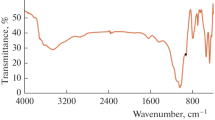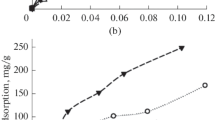Abstract
The adsorption of 1,10-phenanthroline (OP) onto some clays and oxides was studied as a function of concentration, pH, and time. The adsorption was found to be irreversible and the isotherms, except for silica gel, were hyperbolic and gave rise to plots similar to that of Langmuir. Kinetic and light scattering studies show that OP is adsorbed as a micellar unit composed on the average of 3.5 molecules/micelle. This fact explains the overestimation observed in the surface areas of some sorbents since no true monomo-lecular layer of OP is formed on the surfaces. The adsorption was also found to be pH dependent, attaining a maximum, independent of the sorbent, at about pH 6. This maximum was approximately at the same pH in which only the molecular form of OP began to be present. The partial desorption of OP as the pH increased beyond 6 is possibly associated with the aggregation of micelles on the surfaces.
Резюме
Изучалась адсорбция 1,10-Фенатролина (ОП) некоторыми глинами и окислами как функция концентрации, рН, и времени. Адсорбция оказалась необратимой и изотермы, кроме изотерм для кремневого геля, были гиперболические, которые позволили построить графики подобные графикам Лангмуира. Кинетические исследования и изучения с помощью рассеяния света показывают, что ОП адсорбируется как мицелловая единица, составленная в среднем из 3,5 молекул/ мицелла. Этот факт объясняет переоценку, замеченную в поверхностных зонах некоторых сорбентов, поскольку настоящие мономолекулярные слои ОП не формируются на поверхностях. Было обнаружено также, что адсорбция зависит от рН, доходя до максимума, независимо от сорбента, при рН равном примерно 6. Этот максимум был приблизительно при том же рН для случая, когда только молекулярная форма ОП начала появляться. Частичная адсорбция ОП при увеличении рН свыше 6 возможно связана с объединением мицелля на поверхностях. [N. R.]
Resümee
Die Adsorption von 1,10-Phenanthrolin (OP) an einige Tone und Oxide wurde in Abhängigkeit von Konzentration, pH, und Zeit untersucht. Es zeigte sich, daß die Adsorption irreversibel ist, und daß die Isothermen, mit Ausnahme von Silica-Gel, hyperbolisch sind und Darstellungen ähnlich denen von Langmuir ermöglichen. Kinetische und Lichtstreuungs-Untersuchungen zeigen, daß OP in Form einer micellaren Einheit aus durchschnittlich 3,5 Molekülen/Micelle adsorbiert wird. Diese Tatsache erklärt die Überbewertung, die in den Oberflächenbereichen einiger Adsorber beobachtet wurde, da keine echten monomolekularen Schichten von OP auf den Oberflächen gebildet werden. Es zeigte sich, daß die Adsorption pH-abhängig ist, und unabhängig vom Adsorber ein Maximum bei pH ~6 erreicht. Dieses Maximum war etwa bei dem gleichen pH, bei dem nur die molekulare Form von OP aufzutreten beginnt. Die teilweise Desorption von OP, wenn der pH über 6 ansteigt, hängt möglicherweise mit der Aggregation von Micellen auf den Oberflächen zusammen. [U. W.]
Résumé
L’adsorption de 1,10-phenalthroline (OP) sur certains argiles et oxides a été étudiée en fonction de la concentration, du pH, et du temps. On a trouvé que l’adsorption était irréversible et que les isothermes, sauf pour le gel de silice, étaient hyperboliques, produisant des graphes semblables à celui de Langmuir. Des études kinétiques et de dispersion de lumière montrent que OP est adsorbé en tant qu’unité micellaire composée en moyenne de 3,5 molécules/micelle. Ce fait explique la surestimation observée dans les régions de surface de quelques sorbants puisqu’aucune vraie couche monomoléculaire de OP n’est formée sur les surfaces. On a aussi trouvé que l’adsorption était dépendante du pH, atteignant un maximum, indépendant du sorbant, à ~pH 6. Ce maximum était approximativement au même pH auquel seule la forme moléculaire de OP commençait à être présente. La désorption partielle de OP lorsque le pH croissait au-delà de 6 est possiblement associée avec l’aggrégation de micelles à la surface. [D. J.]
Similar content being viewed by others
References
Berkheiser, V. E. and Mortland, M. M. (1977) Hectorite complexes with Cu(II) and Fe(II)-1,10-phenanthroline chelates: Clays & Clay Minerals 25, 105–112.
Bower, C. A. (1963) Adsorption of o-phenanthroline by clay minerals and soils: Soil Sci. 95, 192–195.
de Boer, J. H., Houken, G. M. M., Lippens, B. C., Meijs, W. H., and Walrave, W. K. A. (1962) Adsorption of lauric acid on aluminium oxides and hydroxides: J. Catal. 1, 1–7.
de Haan, F. A. M. (1965) The interaction of certain inorganic anions with clays and soils: Thesis, Wageningen, Holland, 167 pp.
Dobias, B. (1977) Adsorption and electrokinetic phenomena in the system solic-micellar solution of a surface active substance: Colloid Polymer Sci. 255, 682–690.
Dobias, B. (1978) Adsorption kinetics of surface active substances from micellar solutions on solid phase: Colloid Polymer Sci. 256, 465–470.
Edwards, D. G., Posner, A. M., and Quirk, P. (1965a) Repulsion of chloride by negatively charged clay surfaces. Part 2. Monovalent cation montmorillonites: Trans. Faraday Soc. 61, 2816–2819.
Edwards, D. G., Posner, A. M., and Quirk, P. (1965b) Repulsion of chloride by negatively charged clay surfaces. Part 3. Divalent and trivalent cation clays: Trans. Faraday Soc. 61, 2820–2823.
Giles, C. H. and Trivedi, A. S. (1969) A rapid method for determination of specific surface of solids by dye adsorption: Chem. Ind. (London), 1246–1427.
Herz, A. H. (1978) Aggregation of sensitizing dyes in solution and their adsorption onto silver halides: Advan. Colloid Interface Sci. 8, 237–298.
Lawrie, D. C. (1961) A rapid method for the determination of approximate surface areas of clays: SoilSci. 92, 188–191.
Peinemann, N., Ferreiro, E. A., and Helmy, A. K. (1972) Estudio mineral’ogico de una montmorillonita de Cerro Bandera (Provincia del Neuquén, Repüblica Argentina): Revista Asoc. Geol. Argentine 27, 399–405.
Perkampus, H. H. and Kohler, H. (1960) Absorption spectra and basicity of phenanthrolines and related compounds: Z. Electrochem. 64, 365–373.
Tanford, C. (1961) Physical Chemistry of Macromolecules: Wiley, New York, 710 pp.
Van Olphen, H. (1970) Determination of surface areas of clays. Evaluation of methods: in Surface Area Determination, D. H. Everett and R. H. Ottewill, eds., Butter-worths, London, p. 255.
Author information
Authors and Affiliations
Rights and permissions
About this article
Cite this article
de Bussetti, S.G., Ferreiro, E.A. & Helmy, A.K. Adsorption of 1,10-Phenanthroline by Some Clays and Oxides. Clays Clay Miner. 28, 149–154 (1980). https://doi.org/10.1346/CCMN.1980.0280212
Received:
Accepted:
Published:
Issue Date:
DOI: https://doi.org/10.1346/CCMN.1980.0280212




